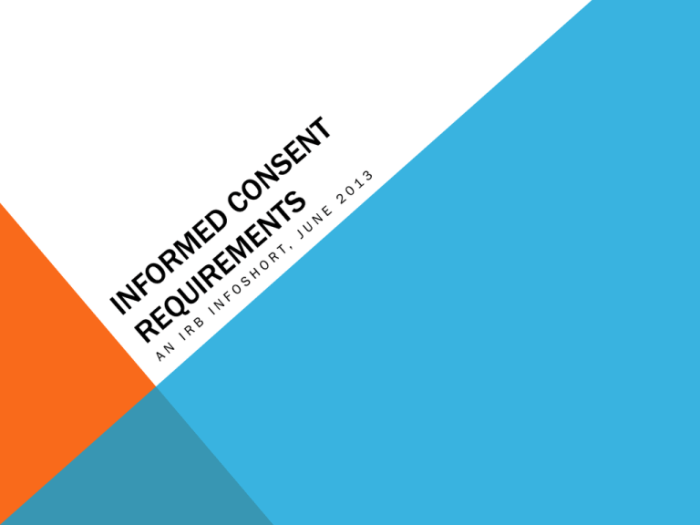Roi can also stand for release of informed consent – Release of Informed Consent (ROI), a pivotal concept in healthcare, entails obtaining a patient’s voluntary and knowledgeable agreement to undergo medical procedures or participate in research. This article delves into the significance of ROI, its legal and ethical implications, and best practices for its implementation.
By empowering patients with essential information about their treatment options, ROI safeguards their autonomy, fosters trust, and promotes informed decision-making.
Definition of Release of Informed Consent (ROI)

Release of Informed Consent (ROI) is a legal document that provides evidence that a patient has been informed about the risks and benefits of a medical procedure or treatment and has given their consent to proceed. It is an essential part of the healthcare process and helps protect both patients and healthcare providers.
ROI is typically used in situations where there is a significant risk of harm or discomfort to the patient, such as surgery, invasive procedures, or the use of experimental treatments. It is also required in cases where the patient’s mental capacity is impaired or they are unable to provide consent themselves.
Importance of ROI in Healthcare

ROI plays a crucial role in healthcare by ensuring that patients are fully informed about the potential risks and benefits of their treatment. This information allows patients to make informed decisions about their own healthcare and provides a legal basis for healthcare providers to proceed with treatment.
ROI also protects the rights of patients by ensuring that they are not subjected to medical procedures or treatments without their consent. It helps to build trust between patients and healthcare providers and promotes a sense of autonomy and respect for patient decisions.
Elements of a Valid ROI, Roi can also stand for release of informed consent
A valid ROI must include the following elements:
- A description of the proposed procedure or treatment, including its risks and benefits
- A statement that the patient has been given an opportunity to ask questions and has had all of their questions answered
- A statement that the patient understands the risks and benefits of the procedure or treatment and has consented to proceed
- The patient’s signature and the date
Process of Obtaining ROI
The process of obtaining ROI typically involves the following steps:
- The healthcare provider explains the proposed procedure or treatment to the patient, including its risks and benefits.
- The patient is given an opportunity to ask questions and have all of their questions answered.
- The healthcare provider reviews the ROI with the patient and ensures that they understand its contents.
- The patient signs the ROI and the date is noted.
It is important to note that the process of obtaining ROI should be conducted in a clear and understandable manner. The healthcare provider should use language that is easy for the patient to understand and should avoid using medical jargon or technical terms.
Challenges in Obtaining ROI
Healthcare providers may face challenges in obtaining ROI from patients. Some of these challenges include:
- Patients may not be able to understand the risks and benefits of the procedure or treatment.
- Patients may be under duress or coercion to sign the ROI.
- Patients may have a language barrier or other communication difficulties.
Healthcare providers can overcome these challenges by using clear and understandable language, providing interpreters for patients with language barriers, and taking the time to answer all of the patient’s questions.
Consequences of Failing to Obtain ROI
Failing to obtain ROI can have serious legal and ethical consequences. Healthcare providers who fail to obtain ROI may be held liable for battery or negligence. They may also lose their license to practice medicine.
In addition to the legal consequences, failing to obtain ROI can also damage the patient-provider relationship. Patients who feel that they have not been properly informed about their treatment may be less likely to trust their healthcare provider and may be more likely to seek legal action.
Best Practices for ROI
Healthcare providers can implement the following best practices to ensure that they are obtaining ROI in a valid and ethical manner:
- Use clear and understandable language in the ROI.
- Provide interpreters for patients with language barriers.
- Take the time to answer all of the patient’s questions.
- Obtain the patient’s signature on the ROI and note the date.
- Keep a copy of the ROI in the patient’s medical record.
By following these best practices, healthcare providers can help to protect their patients and themselves from legal and ethical risks.
Top FAQs: Roi Can Also Stand For Release Of Informed Consent
What are the key elements of a valid ROI?
A valid ROI includes a description of the procedure, potential risks and benefits, alternatives, and the patient’s right to refuse or withdraw consent.
What are the consequences of failing to obtain ROI?
Failing to obtain ROI can result in legal liability, damage to provider-patient relationships, and compromised patient care.

